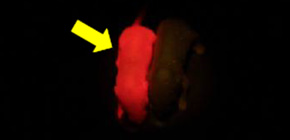
Visualization of DNA methylation through the creation of knockin mouse MethylRO
MethylRO enabled these researchers to track and examine the process of DNA methylation
A group of researchers* from Osaka University, Kyushu University, and Fuso Pharmaceutical Industries, Ltd. succeeded in visualizing DNA methylation in mice in situ through the creation of knockin mouse. They named this mouse MethylRO (methylation probe in ROSA26 locus).
*
• Research Institute for Microbial Diseases, Osaka University -- UEDA Jun , Specially Appointed Assistant Professor, YAMAGATA Kazuo , Specially Appointed Associate Professor
• Faculty of Medical Sciences, Kyushu University -- OKAWA Yasuyuki , Associate Professor
• Fuso Pharm aceutical Industries Ltd. -- YAO Tatsuma , Fellow
DNA methylation is involved in controlling transcription activity of genes. Changes in DNA methylation are related to the processes of normal generation and the development of cancers; however, these changes have only been seen as snapshots in conventional methods. The development of the MethylRO mouse enabled these researchers to track and examine DNA methylation changes in individual mice in situ. The researchers conclude that the MethylRO mouse will be useful in studying cell generation, stem cells, as well as in the development of anticancer drugs.
DNA methylation is a chemical modification occurring on cytosine and the function of methylated cytosine is different from that of normal cytosine. DNA methylation is capable of suppressing transcription activity in highly methylated genetic areas and is involved in genetic imprinting, activating X-chromosome, and controlling transposons. DNA methylation plays an important role in normal course of development. Abnormalities in the control of DNA methylation is related to the development of cancer and other diseases. Thus, the development of anticancer drugs targeting DNA methylation is being conducted. However, in conventional experiment methods, only DNA methylation during specified periods has been observed; therefore, the development of a method for tracking kinetic changes in epigenetics has been required.
This group made a knockin mouse that expresses a red fluorescent protein (RFP)-fused methyl-CpG-binding domain (MBD) protein from the ROSA26 locus ubiquitously. Moreover, by using cells from this reporter mouse and a less-invasive live-cell imaging technology developed by Dr. Yamagata, this group succeeded in live cell imaging of a long process from pre-implantation early embryogenesis to the establishing of ES cells in mice. Furthermore, by examining image data, this group found that, as cell differentiation progressed, methylated DNA in the genetic area called centromere increased and a heterochromatin structure was formed. From these findings, this group demonstrated that the pattern of intranuclear DNA methylation could serve as a barometer for cell differentiation and disease states.
Abstract
In mammals, DNA is methylated at CpG sites, which play pivotal roles in gene silencing and chromatin organization. Furthermore, DNA methylation undergoes dynamic changes during development, differentiation, and in pathological processes. The conventional methods represent snapshots; therefore, the dynamics of this marker within living organisms remains unclear. To track this dynamics, we made a knockin mouse that expresses a red fluorescent protein (RFP)-fused methyl-CpG-binding domain (MBD) protein from the ROSA26 locus ubiquitously; we named it MethylRO (methylation probe in ROSA26 locus). Using this mouse, we performed RFP-mediated methylated DNA immunoprecipitation sequencing (MeDIP-seq), whole-body section analysis, and live-cell imaging. We discovered that mobility and pattern of heterochromatin as well as DNA methylation signal intensity inside the nuclei can be markers for cellular differentiation status. Thus, the MethylRO mouse represents a powerful bioresource and technique for DNA methylation dynamics studies in developmental biology, stem cell biology, as well as in disease states.

Figure 1

Figure 2

Figure 3
To learn more about this research, please read the full research report entitled " Heterochromatin Dynamics during the Differentiation Process Revealed by the DNA Methylation Reporter Mouse, MethylRO " at this page of the Stem Cell Reports website.
Related link :
